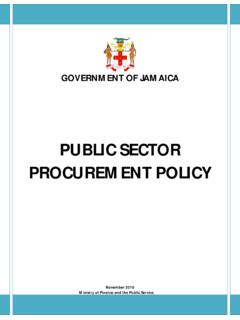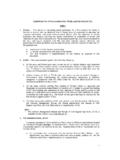Transcription of PREFERENTIAL PROCUREMENT REGULATIONS, …
1 IMPLEMENTATION GUIDE: PREFERENTIAL PROCUREMENT regulations 2011 1 IMPLEMENTATION GUIDE PREFERENTIAL PROCUREMENT regulations , 2011 PERTAINING TO THE PREFERENTIAL PROCUREMENT POLICY FRAMEWORK ACT, ACT NO 5 OF 2000 1 December 2011 IMPLEMENTATION GUIDE: PREFERENTIAL PROCUREMENT regulations 2011 2 TABLE OF CONTENTS PART ONE general 1. ACRONYMS AND ABBREVIATIONS 2. PURPOSE 3. APPLICABILITY 4. BROAD-BASED BLACK ECONOMIC EMPOWERMENT STATUS LEVEL CERTIFICATES PART TWO INVITATION OF BIDS 5. PLANNING, STIPULATION OF PREFERENCE POINT SYSTEM TO BE UTILISED AND DETERMINATION OF DESIGNATED SECTORS 6. BIDS BASED ON FUNCTIONALITY AS A CRITERION 7. LOCAL PRODUCTION AND CONTENT 8.
2 SERVICES RENDERED BY TERTIARY INSTITUTIONS AND PUBLIC ENTITIES PART THREE EVALUATION OF BIDS 9. DISCOUNTS 10. SUB-CONTRACTING 11. EVALUATION OF BIDS BASED ON FUNCTIONALITY AS A CRITERION IMPLEMENTATION GUIDE: PREFERENTIAL PROCUREMENT regulations 2011 3 12. EVALUATION OF BIDS BASED ON A STIPULATED MINIMUM THRESHOLD FOR LOCAL PRODUCTION AND CONTENT 13. THE PREFERENCE POINT SYSTEMS 14. EVALUATION OF BIDS THAT SCORED EQUAL POINTS 15. CANCELLATION AND RE-INVITATION OF BIDS PART FOUR 16. AWARD OF CONTRACTS PART FIVE 17. REMEDIES 18. TAX CLEARANCE 19. BIDDING DOCUMENTS 20. SALE AND LETTING OF ASSETS 21. TRANSITIONAL ARRANGEMENTS IMPLEMENTATION GUIDE: PREFERENTIAL PROCUREMENT regulations 2011 4 PART ONE general 1.
3 ACRONYMS AND ABBREVIATIONS AO /AA Accounting Officer / Accounting Authority B-BBEEA Broad Based Black Economic Empowerment Act, Act No 53 of 2003 BVA BEE Verification Agency CCA Closed Corporations Act, Act No 69 of 1984 EMEs Exempted Micro Enterprises IRBA Independent Regulatory Board of Auditors MFMA Municipal Finance Management Act, Act No 56 of 2003 PFMA Public Finance Management Act, Act No. 1 of 1999 (as amended by Act 29 of 1999) PPPFA PREFERENTIAL PROCUREMENT Policy Framework Act, No 5 of 2000 QSE Qualifying Small Enterprise SANAS South African National Accreditation System SARB South African Reserve Bank SARS South African Revenue Services SASAE South African Standard on Assurance Engagements SCM Supply Chain Management IMPLEMENTATION GUIDE: PREFERENTIAL PROCUREMENT regulations 2011 5 2.
4 PURPOSE This Guide is intended to assist Accounting Officers and Accounting Authorities with the implementation of the PREFERENTIAL PROCUREMENT regulations , 2011 issued in terms of section 5 of the PREFERENTIAL PROCUREMENT Policy Framework Act, Act Number 5 of 2000 (PPPFA). The Guide should be read and utilized in conjunction with other relevant SCM related prescripts, instructions, circulars and guidelines. 3. APPLICABILITY Institutions The PREFERENTIAL PROCUREMENT regulations , 2011 are applicable to organs of state as contemplated in section 1 (iii) of the PPPFA and all public entities listed in Schedules 2, 3A, 3B, 3C and 3D to the PFMA and municipal entities.
5 These organs of state and entities are hereafter referred to as institutions in this Guide. Preference point systems The 80/20 preference point system is applicable to bids* with a Rand value equal to, or above R30 000 and up to a Rand value of R1 million (all applicable taxes included). Institutions may apply the 80/20 preference point system to price quotations with a value less than R30 000 if and when appropriate. The 90/10 preference point system is applicable to bids with a Rand value above R1 million (all applicable taxes included). The value referred to in paragraphs and distinguishing the 80/20 and 90/10 preference point systems has been increased from R500 000 to R1 million.
6 It must be pointed out that the prescribed threshold values within which AOs /AAs may procure services, works or goods by means of petty cash, verbal / written price quotations or advertised competitive bids are not affected by the PREFERENTIAL PROCUREMENT regulations , 2011. * which is referred to as tenders in the PPPFA and the PREFERENTIAL PROCUREMENT regulations , 2011 include advertised competitive bids, written price quotations or proposals. IMPLEMENTATION GUIDE: PREFERENTIAL PROCUREMENT regulations 2011 6 4. BROAD-BASED BLACK ECONOMIC EMPOWERMENT (B-BBEE) STATUS LEVEL CERTIFICATES Bidders are required to submit original and valid B-BBEE Status Level Verification Certificates or certified copies thereof together with their bids, to substantiate their B-BBEE rating claims.
7 Bidders who do not submit B-BBEE Status Level Verification Certificates or are non-compliant contributors to B-BBEE do not qualify for preference points for B-BBEE but should not be disqualified from the bidding process. They will score points out of 90 or 80 for price only and zero (0) points out of 10 or 20 for B-BBEE. A trust, consortium or joint venture must submit a consolidated B-BBEE Status Level Verification Certificate for every separate bid. Public entities and tertiary institutions must also submit B-BBEE Status Level Verification Certificates together with their bids. If an institution is already in possession of a valid and original or certified copy of a bidder s B-BBEE Status Level Verification Certificate that was obtained for the purpose of establishing the database of possible suppliers for price quotations or that was submitted together with another bid, it is not necessary to obtain a new B-BBEE Status Level Verification Certificate each time a bid is submitted from the specific bidder.
8 Such a certificate may be used to substantiate B-BBEE rating claims provided that the closing date of the bid falls within the expiry date of the certificate that is in the institution s possession. Each time this provision is applied, cross-reference must be made to the B-BBEE Status Level Verification Certificate already in possession for audit purposes. AOs / AAs must ensure that the B-BBEE Status Level Verification Certificates submitted are issued by the following agencies: Bidders other than EMEs (a) Verification agencies accredited by SANAS; or (b) Registered auditors approved by IRBA. Bidders who qualify as EMEs (a) Accounting officers as contemplated in the CCA; or (b) Verification agencies accredited by SANAS; or (c) Registered auditors.
9 (Registered auditors do not need to meet the prerequisite for IRBA s approval for the purpose of conducting verification and issuing EMEs with B-BBEE Status Level Certificates). IMPLEMENTATION GUIDE: PREFERENTIAL PROCUREMENT regulations 2011 7 VALIDITY OF B-BBEE STATUS LEVEL VERIFICATION CERTIFICATES Verification agencies accredited by SANAS These certificates are identifiable by a SANAS logo and a unique BVA number. Confirmation of the validity of a B-BBEE Status Level Verification Certificate can be done by tracing the name of the issuing Verification Agency to the list of all SANAS accredited agencies. The list is accessible on The relevant BVA may be contacted to confirm whether such a certificate was issued.
10 As a minimum requirement, all valid B-BBEE Status Level Verification Certificates should have the following information detailed on the face of the certificate: The name and physical location of the measured entity; The registration number and, where applicable, the VAT number of the measured entity; The date of issue and date of expiry; The certificate number for identification and reference; The scorecard that was used (for example EME, QSE or Generic); The name and / or logo of the Verification Agency; The SANAS logo; The certificate must be signed by the authorized person from the Verification Agency; and The B-BBEE Status Level of Contribution obtained by the measured entity.
















